sional courtesy, maybe even ski with the fellow professional----but
I soon noticed he wasn't very outgoing, like a normal confident ski
instructor; and then, when we parted, I noticed he didn't ski worth
Our Bottomless Topic: "How to Turn"---A Preview --- 75
a darn. Unless you do it right, for the right reasons and for fun,
impersonating a ski instructor is as big a crime as impersonating a
law-enforcement officer in my book.)
One item I've always believed in over my shirt and under my
vest . . . is a radio harness, even if I'm not carrying a ski-school ra-
dio that day: it sits on your chest with a pocket for a pen n note-
pad with some lesson plans or student names, ski area maps, and
whatnot, and maybe my book of Ski-boy Poetry or the Heinsian DHS
Schedule from the back of this book. When you're really in the
business for your students, I like to carry an old credit card to use
as a ski scraper, and a small whetstone for getting burrs off of
rough edges. For what it's worth, I don't go anywhere without a
couple of other nifty little items: a lighter and a small candle in
that radio harness; and, on my cut-offs belt, I often have a very
small leather-man multi-tool, in case I need to fix a ski-boot buckle
or a pole-strap or something. In my jacket, I always have another
lighter and a knife, a candy bar, and a tiny space blanket. I ski
alone often-times at the ski areas, through the trees and whatnot,
and it is possible I could go unmissed by my comrades, even ig-
nored by some, if I didn't make it down; these are also important
things to routinely have along in case I take a day-trip to the back-
country, as you'll see. . . . And there's another reason why I believe
in the radio harness: the better you ski, and the more often you are
seen at the mountain mingling with the locals or the crew, there
could come a time when the local authorities throw you a radio for
an emergency search-n-rescue effort, like maybe for one of your
comrades who may be buried in an avalanche, or a snowboarder
who unlawfully ventured out-of-bounds---it's not likely, but this
type of last-minute enlistment, or drafting or recruiting or deputi-
zation, has happened to me a couple of times over the years. I've
seen ski instructors lose expensive radios or walkie-talkies because
they didn't have a routine place to put it; they can cost several-
hundred-dollars apiece (the radios, not the ski instructors), and
you don't want to treat them like an inconvenience (again, the ra-
dios, not the ski instructors), especially when someone's life de-
pends on it. One time, I saw a famous extreme skier lose a radio
during his glorified Extreme Skiing Clinic: his clients lost a good
half-hour or so of lesson-time, and it was embarrassing for him. . . .
And one more thing: I don't believe in putting the radio in an offi-
cial jacket pocket, because, when you take the jacket off indoors,
you may not have the radio with you when you need it; on your
chest at all times is the best place ever---just make sure you don't
76 --- Heinsian DOWNHILL SKIING
have it keyed-on to talk at the wrong instant when you go to the
rest-room.
Oh, by the way, remember the big thick wool ski sweater I
didn't opt for?---that's because, over my thin turtleneck and regular
shirt, I can add an insulated ski vest, which ought to be optional
indoors or out. So it helps if your jacket is roomy enough to ac-
commodate a decent vest; but you want some room to move in
your arms and shoulders just like your legs. Because the jacket is
more important weather-wise and usually has important stuff in it,
you'll almost never see me without it; if I am skiing in just a vest,
it's probably a bunny-hill phenomenon, and the jacket is usually
close by hanging on a fence.
(I've seen some weird jacket deals for ski schools over the
years. Joe Waggoner at Bridger Bowl in the early 1980s used to joke
about hiring his instructors based on what size jackets were still
hanging unassigned in the closet. Some ski-school directors don't
realize how important the jacket decisions are; and sometimes I
think I write my own ski books just to be able get the jacket I want.
And, over time, because of our greedy dog-eat-dog economy, I've
noticed it seems that "Large" jackets aren't as large as they used to
be---the propagandish marketing tag will tell you how nice and
streamlined they are, how much wind they won't catch, without
admitting how much they won't cover you or let you move.
(In contrast to the $400 jacket ski school I mentioned, one ski
school I worked for 2003-05 was so cheap, they issued us a thin $40
spring-time nylon shell as our official ski-school jacket: there was
no way it would keep us warm during most of the Montana winter,
so we had to wear some thick civilian garment under it anyway,
which was difficult because spring shells aren't usually designed to
accommodate thick parkas underneath---when you added what
you needed underneath, you could barely move. Another thing
they did: they hired more part-time instructors than they had jack-
ets, so a lot of instructors had to play musical-chairs with those
jackets . . . and their personal belongings---it was common for a
one-day-a-weeker to be told to raid a full-timer's jacket on his day-
off. Getting away from the uniform-deal alone was good reason for
not working on that ski school. . . . For what it's worth, one of the
most famous porn stars in the world once worked for that same ski
school, and I don't think she ever talks of any fond memories of
having worked there.)
Let's finish up this clothing-and-accessories section by talking
about the rest of the accoutrements: hats and gloves, goggles and
Our Bottomless Topic: "How to Turn"---A Preview --- 77
sunglasses, sunscreen, and the helmet debate.
The ski hat is a no-brainer, as most of your heat is lost up out
through your head: "If you want to keep your feet warm, put on a
hat," the old saying goes. Even if you think its warm enough out to
ski without a hat, you should always have a hat with you---I've
seen many a ski instructor get caught in a squall without their hat.
(Unfortunately, I've noticed in recent years: older ski hats gave you
plenty of material and volume to help you stay warm; but, in these
greedy economic times, most of your newer hats are a third the
material, extremely tight volume, and triple the price---all in the
name of "style or fashion." To retaliate, I now get most of my hats a
lot cheaper and warmer from the farm-n-ranch stores.) One thing I
like about hats versus helmets: hats are more goggle-friendly,
whereas helmets tend to stretch the elastic too far when the goggles
are not on your face. You might not be able to change the color of
your jacket or pants, but you can usually choose the color or your
hat and have a few to pick from: a dark-colored hat will keep you
warmer than a light-colored one.
Ski gloves are better than mittens for pole usage; and I usually
wear extra thin glove-liners on cold days---they are easy to store in
your jacket when you don't want them. Those chemical hand-
warmer packets are extremely nice to have on hand much of the
winter, so be sure your gloves are roomy enough to accommodate
them on the knuckles. I do keep a pair of warm mittens in my gear-
bag just in case I have to go out on a dangerously cold day Re-
member, as nifty as ski gloves are for pole usage, they don't have to
be official items from a ski shop. (As with hats and jackets, same
with my gloves: I buy thick leather-n-canvas ranch gloves for less
than $10 a pair, even in 2010, and I've noticed they are more dura-
ble and stay drier than expensive $75 ski gloves---you can add
mink oil for water-proofing.) Rope-tows and carrying your skis
can be hard on ski gloves (which is another reason I like the more
durable ranch gloves); in fact, it wasn't too many years ago, ski in-
structors galore went around giving expensive ski lessons with
duct-tape repairs on their ski gloves (---check out my country song
"Faded Gloves").
A neck-gaitor is nice on the coldest days, but one more item
that I really believe in, a brother to your glove liners, is a thin full-
head-cover that goes under your hat---it'll make you look like
Lloyd Bridges on Sea Hunt. What I like about this thin head-cover
is . . . it has an oval peep-hole that's very easy to work with, unlike
the "ski masks" that bank robbers have made famous. (You might
78 --- Heinsian DOWNHILL SKIING
be able to finagle part of a pair of pantyhose by ripping a hole for
your eyes, but I'm not sure what size you would buy---I wouldn't
want you to get varicose veins in your face or something.)
Goggles are a must for skiing, because they make you feel like
you're safe-n-warm indoors, even on a snowy day. Even if it is not
a blustery snowy day, the speed of skiing alone can make your eyes
water. I always have my sunglasses with me too. You don't al-
ways know if it's going to be stormy or clear: the light can be ex-
tremely flat, or the sun can be extremely intense at high altitudes
and with the reflection off the snow---it is triple powerful. I wear
glasses, so I make sure my goggles will fit over them. Then, while
racers prefer single-lens goggles to have less obstruction between
them and the course, the rest of us are wise to prefer double-lenses
because they are warmer and don't fog up so easy. One of the signs
of a good skier is how well you can keep your goggles from fog-
ging up, or unfogging them quick after a rare head-plant while
you've got eight advanced students waiting; seasoned skiers are
even known to ski with them fogged-up if they think they have to.
I remember lonely my goggles to a friend one day my first season
skiing, when I couldn't keep them from fogging up; then, when I
eyes got bombarded by a blizzard, I realized I was going to have to
learn to maintain my goggles at all costs. . . . Remember there are a
couple of brightness options in ski goggles, as some are for dark
days, and some are for sunny days---they may not be for both: you
can get away with skiing with dark goggles on a dark day, but you
can't ski with light goggles on a sunny day unless you want to get
snow-blindness. One thing is for sure: the right goggles do make
your picture look better than the real world (---I am reminded of
my John Conlee parody "Rose-Colored Goggles.") When leaving
the goggles turned up, make sure your sunglasses are good enough
with UltraViolet Ray Protection and Polarization. Believe it or not,
you can burn your eyeballs just like your skin: I've seen skiers with
a horizontal red slit across the whites of their eyes from skiing
without sunglasses a few hours. (For extra credit, check out Lee
Marvin's antique glacier goggles/sunglasses in the movie Death
Hunt.)
Speaking of the sun, sunscreen for your skin is just as impor-
tant as your sunglasses. Full-time ski instructors use sunscreen by
the bucketful---and our face still gets burnt. And I remember my
first year teaching at Red Lodge, Montana: we had an employee
party about April 21, with the lifts running, and I skied in my
shorts, shorter than the ones I wear now and without knee-pads at
Our Bottomless Topic: "How to Turn"---A Preview --- 79
the time---I burned my legs so bad I couldn't bend my knees for a
week. And, all summer long, I couldn't get my white ankles to
catch up with my dark knees---it was awful, that line of demarca-
tion. (One thing nice about my going on sabbatical and into exile a
couple of times from ski-teaching: it's kept my face from getting
overdone a couple of extra winters.)
Now, I don't want to get bogged down in the helmet debate,
but I need to address it some. Yes, skiing can be dangerous---in
fact, it has always been dangerous one way or another,---but a lot of
the danger depends on your attitude and sensible approach to the
sport. In the olden days, broken legs and ankles were probably the
biggest likelihood, because the skis were so long, the boots so un-
supportive, and the "bear-trap" bindings never let go. Then, after
bindings became safer and safer, blown-out knees became more
common, mostly for people falling backwards and fighting to re-
cover, the one way the bindings wouldn't release quite yet, up from
the toe. (Now, as bindings pretty much can release every way fea-
sible or possible, head injuries are a big issue when people ski
faster and crazier on more available easy hard-pack snow on in-
termediate runs. Wild skiers on intermediate slopes smacking into
trees or other skiers are a problem; and so-called extreme skiers
flying over rocky cliffs occasionally bang their head.) My policy is:
don't put yourself into situations where you could smack trees or
cream other skiers, and don't flirt too close with the rocky cliffs. I
have been acknowledged as an expert skier by my peers since
about 1980, most certainly by 1982, and I've never felt the need to
wear a helmet. One irritating thing about the helmet debate that
never gets talked about: whenever you add a few more ounces to
the top of your head, . . . you make your skinny neck that much
more vulnerable. In all my thousands of eggbeater falls, mostly in
the late '70s and early '80s, I probably came closer to breaking my
neck than having a concussion, and this is why I don't feel an ur-
gent need for a helmet---and I don't think we need to pass laws
forcing people to wear helmets.
Speaking of falling while skiing, I had a private lesson with a
persnickety middle-aged woman at Park City about 1983. She'd
been skiing on-n-off for a number of years and was extremely care-
ful; we stuck strictly to the terrain and snow she was comfortable
with, mainly beginner and low-intermediate hard-pack. She was
not in love with me, half-her age, from the get-go, and she was a
hard egg to crack. She tipped over once and slid a little ways about
half-way through the hour. At the end of the lesson, she marched
80 --- Heinsian DOWNHILL SKIING
into the private-lesson office and announced to my boss: "I want
my money back for the lesson. . . . I fell!" I was there wondering
how much trouble I would be in with my boss; and, when she
screamed, "I fell!" my boss and I looked at each other, . . . and he
burst out laughing, inadvertently spitting all over both me and the
lady. Apparently, she had never learned the inevitable: that falling
is a natural part of skiing. A polished expert, skiing hard a hun-
dred days a season might be able to count his number of falls on
one hand, but he still falls. Some overly-cautious intermediate
housewives might hardly ever fall, but they will probably never
make it passed the intermediate hard-pack skill-level either.
. . . The best time to shop for new ski equipment and accesso-
ries, if you want to save money, is in the spring-time sales, when
everything should be at least fifty-percent off, sometimes ninety-
percent off for equipment that's sat on the shelve for more than one
season. It's nice if you can test-ride equipment before you buy, but
that's not always possible. A good place to find used equipment
might be the ski swaps in the fall in ski country right before ski
season, if you know what you're looking for.
The more you learn about skiing, the more you'll know what
you are looking for in equipment, clothing, and accessories, and
sometimes old Buyer's Guide magazines or catalogues can help you
out quite a bit---you might find them in the thrift stores or even in
the magazine racks of laundromats or barber shops. I like to try to
decide what I want . . . and then go out and find it like a smart
shopper. In the retail stores, try not to be influenced by any sales-
person who comes along, as not all of them spend their lives out on
the mountain, and they often have a certain inventory they want to
get rid of, if not a new gimmick they are selling. I cringe when I
hear ski-shop sales-people giving arm-chair ski lessons when
they've never had more than a dozen real-life ski students out on
the real mountain. Don't be afraid to find nifty accessories you can
use for skiing in Army-Surplus Stores or even Snow-Mobile Shops
or Hunting Stores. This ski-boy wears silk-scarf while skiing
sometimes, instead of a turtleneck, and I find these silk scarves in
Western-Wear Stores or Saddle-Shops, not ski shops. (The silk
scarves for skiing are an integral part of my story in The Greatest Ski
Instructor In the West.)
Oh, one more thing about ski equipment and clothing and
accessories: get yourself a gear bag for organized consolidation of
all the smaller more intricate stuff; then put the jacket, pants, and
vest on a couple of beefy hangers; and the skis, boots, and poles
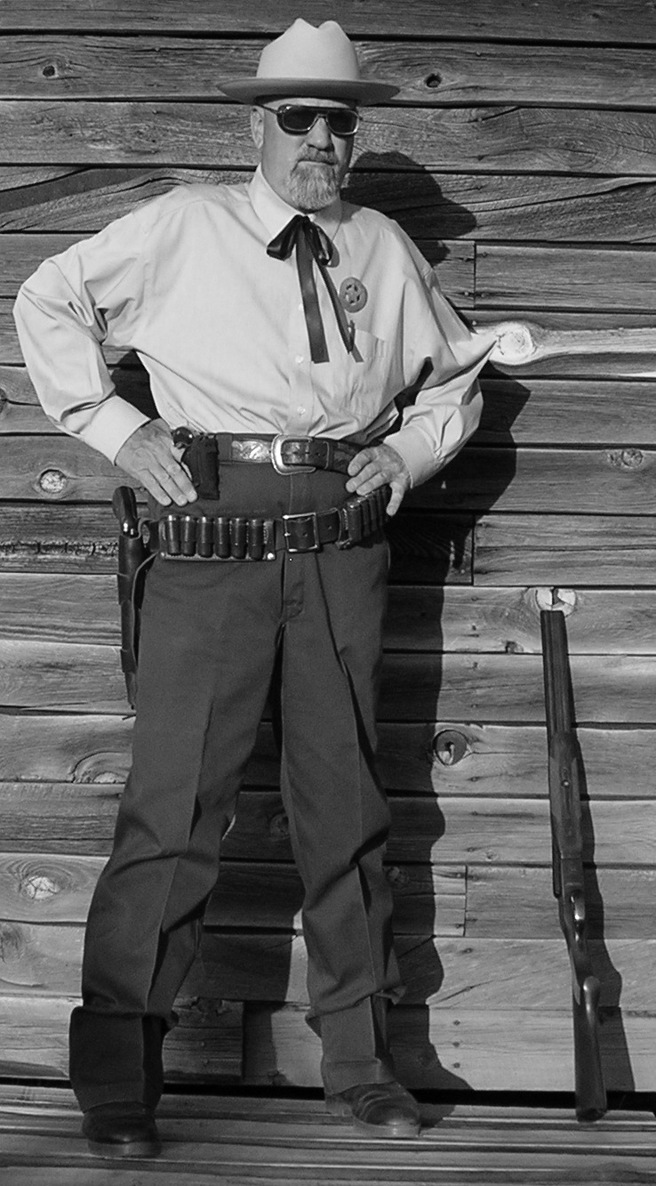
Our Bottomless Topic: "How to Turn"---A Preview --- 81
can stand by themselves---a pair of ski boots can be carried easily
with a handle on a piece of cord buckled into the top flaps, if you
don't want them to be an awkward chore. We can add a small
amount of nifty back-country gear later, if we need to.
. . . That's it for my take on ski equipment and ski clothing and
accessories. You can take my advice, . . . or you can ski in a skimpy
swim-suit all winter. (When I make it big, . . . when I really make it
big, . . . and I've got some free-time to play with, . . . don't be sur-
prised if you see me back at Jackson Hole . . . incognito in some
cumbersone ranch coveralls, "a North Dakota downhill suit," . . .
buying a first-day-beginner request-private ski-lesson . . . with a
PSIA big-wig who stepped on my shoulders-n-head on his climb to
the top. It's gonna be fun.)
I have to laugh: A lot
of my friends and
family tell me I don't
look like a skier---but
that's because they've
never skied with me.
GARY HEINS
---U.S. DANCE TEACHER
(circa 2010)
--Enforcing better
dancing throughout the
West as well, not just
better skiing and
teaching.
What do they want me
to do?---wear my ski
boots everywhere year-
round? Darn stereotypers.
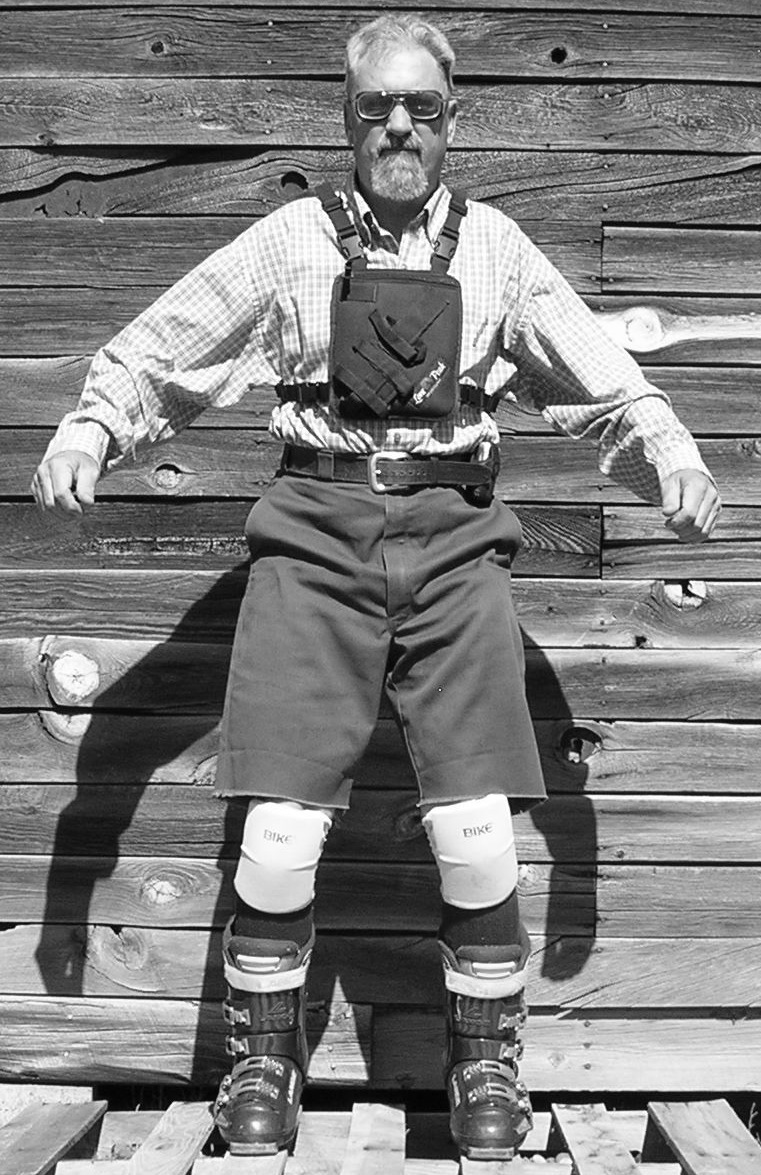
82 --- Heinsian DOWNHILL SKIING
practical inner-skiing layers . . . plus ski boots
---wool socks, knee pads, optional long underwear-n-turtleneck,
cut-offs with familiar pockets, and regular shirt with radio harness
---note the athletic stench---er, stance---before we even hit the slopes
---this is also my recreational-racing suit on festive spring-skiing days---it's fast

Our Bottomless Topic: "How to Turn"---A Preview --- 83
zipper-legged powder pants, bibbed or not
---similar to putting on a pair of western chaps,
leg zippers mean you can put your ski-boots on before the pants,
which makes getting ready a lot easier
---powder pants stay on the same indoors or out-
---Make sure these pants especially allow you to move!
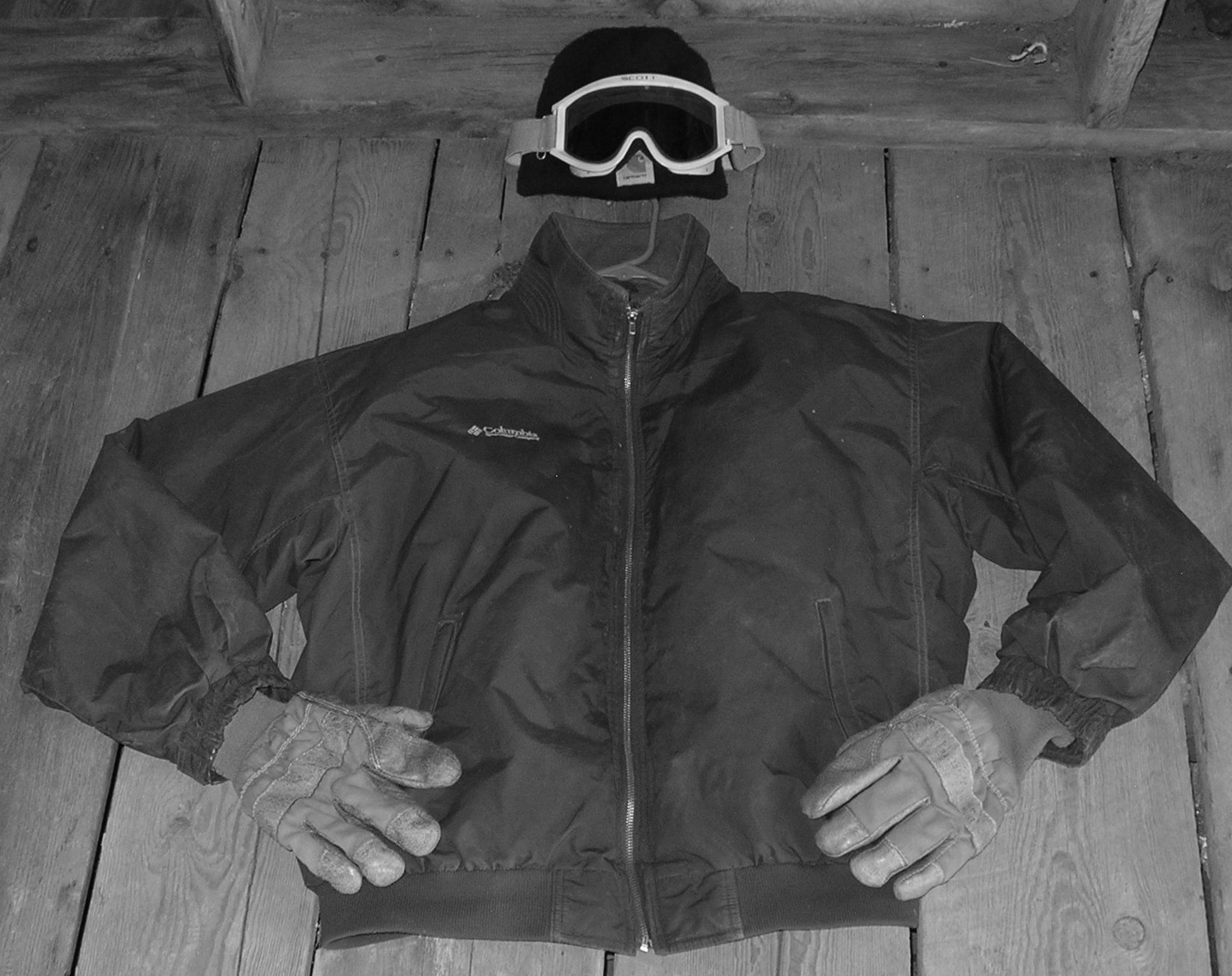
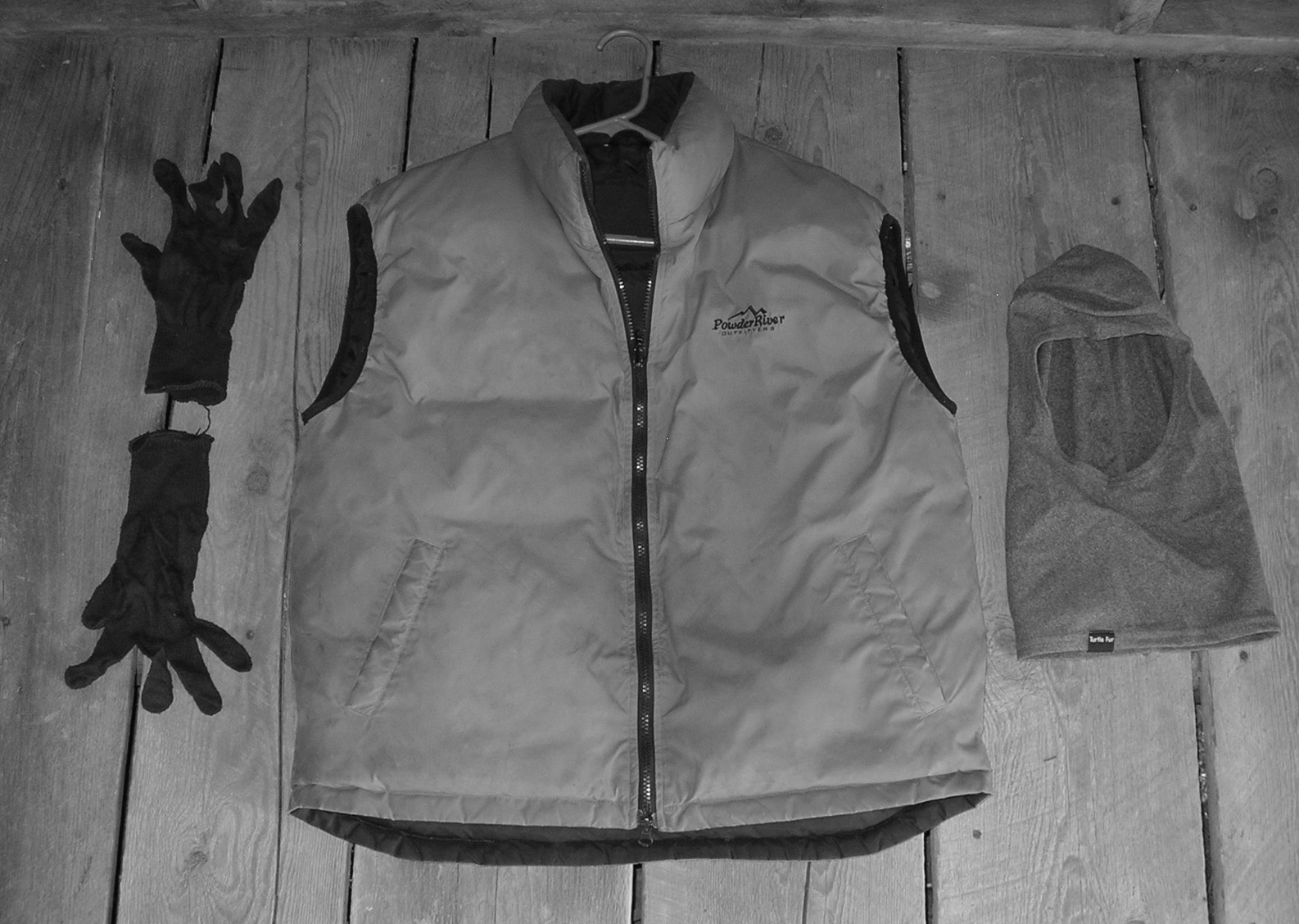
84 --- Heinsian DOWNHILL SKIING
final outer-layer skier clothing & accessories:
ski jacket, hat-n-goggles, gloves
---the rest of the accoutrements are in the umpteen pockets
---an optional vest mid-layer, for cold days,
also thin glove-liners, hand-warmers, thin head-liner, neck-gaitor
---A comfortable skier is a happy skier
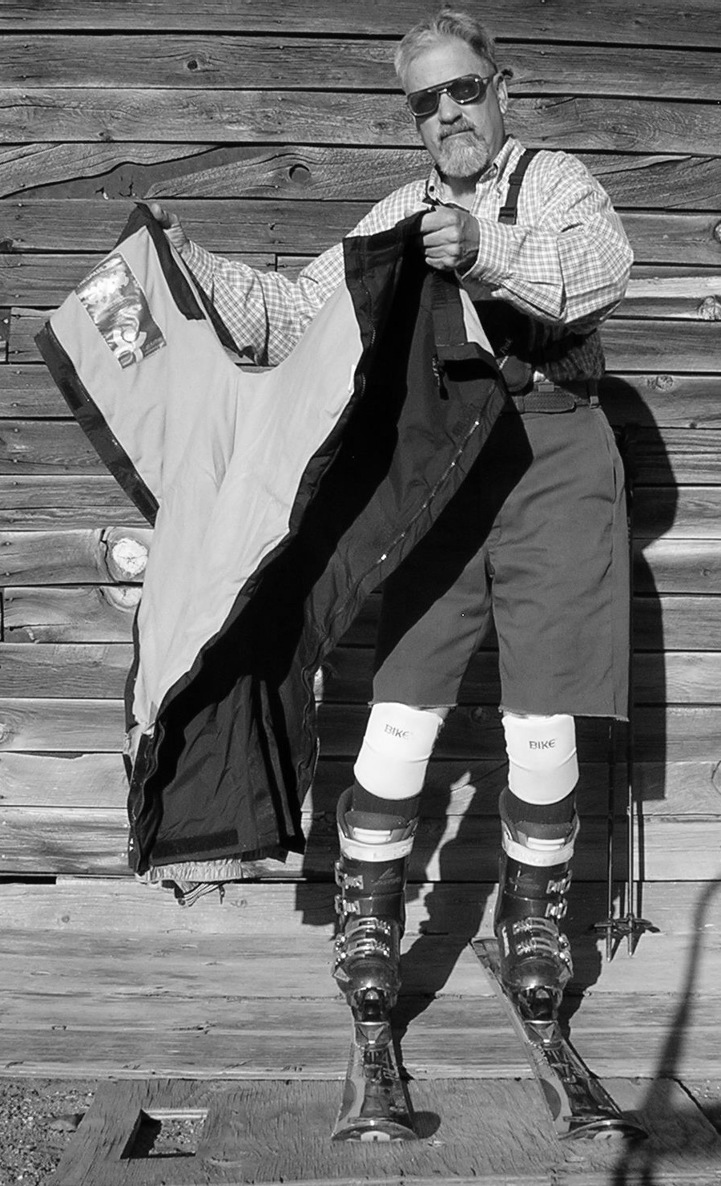
Our Bottomless Topic: "How to Turn"---A Preview --- 85
So: the zipper-legged pants that're easy to put on after ski-boots
. . . are handily easy as a jacket to shed in the heat of battle
---In the color red, they could be used to fight bulls
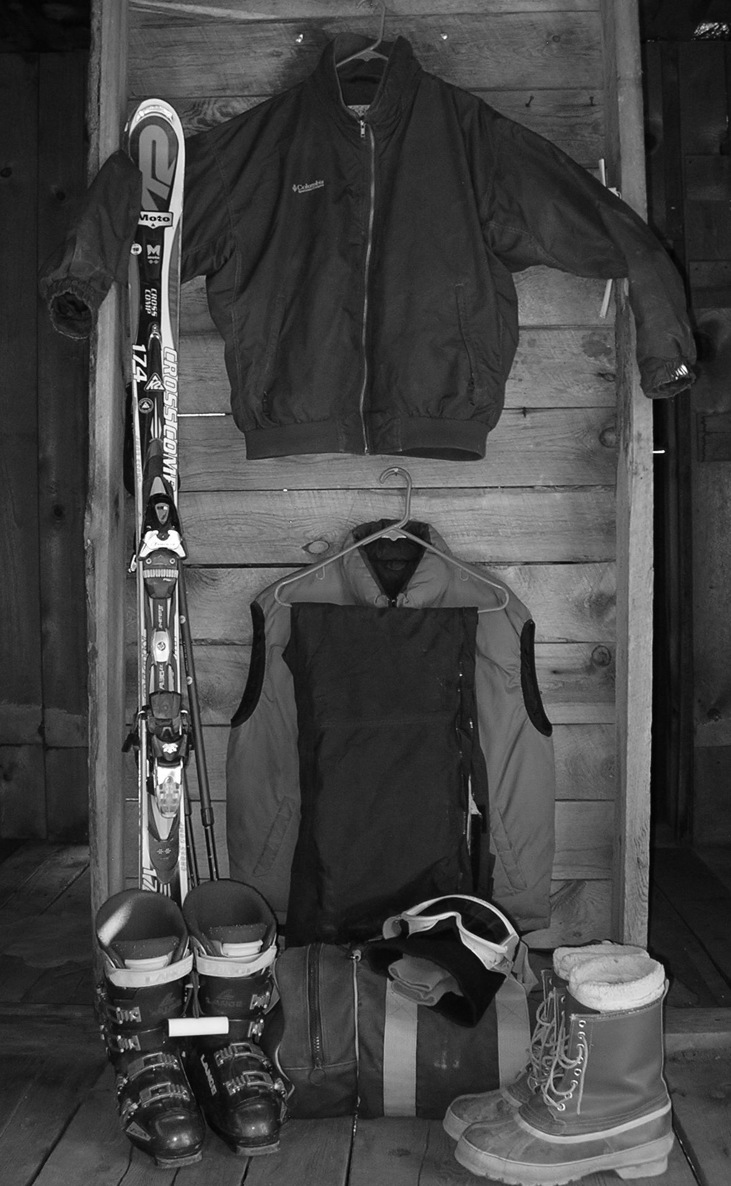
86 --- Heinsian DOWNHILL SKIING
All the gear you need for going skiing
---ski equipment and outer layers obvious,
inner layers and all the a










